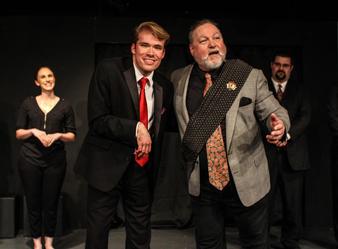
One of the thrills, as well as the challenges, for any actor is finding the physicality for their character. I always feel that once I know how I character walks, I can feel comfortable playing them. This is doubly true for Richard III and apart from the physical challenges of bringing Shakespeare’s monstrous villain to the stage, deciding upon a physicality seemed deceptively simple at first. After Hamlet, Richard III is arguably Shakespeare’s most iconic character, instantly recognizable with his hunched back, withered arm, and crippled leg. However, there are a myriad of choices within these parameters. Some actors have chosen to mitigate the disability (a choice which actually dehumanizes Richard since it robs him of the source of his anger). I was glad for our production, I would get the opportunity to play Richard, hunched back and all. I had plenty of models to study. There was Anthony Sher’s “bottled spider,” Richard played on crutches. Although I enjoyed his excellent memoir The Year of the King, which I thoroughly recommend to any actor undertaking the role, crutches would have distracted from other elements of our production. Ian McKellen’s fascist Richard seemed more like a stroke victim but our production also had fascist undertones so I generally tried to avoid anything like McKellen’s interpretation.
In several conversations about commedia, it began to occur to me that Richard was a character who leads with his head, a thinker stuck in a world of brutes. Just as Sher adopted the image of the bottled Spider for his portrayal, I decided to take on a “spirit animal” for Richard. While the “bunch-backed toad” and “ape” are arresting images, these never felt quite right. They were, after all, insults heaped upon him by his enemies. The boar seemed an obvious choice, both brainy and strong, but at 5’ 7” and weighing something less than 150 lbs., this did not feel like the best use of my physicality. Still, with the thought of how useful a creature as my model would be, I continued to explore the text. Then in rehearsal, one line began to stick out. Richard attacks Elizabeth and her family, mocking their swift advancement, saying that “the world is grown so bad” that “wrens make prey where eagles dare not perch.” This I realized, is how Richard sees himself, an eagle amongst wrens. As I began to develop the twisted figure of Richard, I began to focus on making my movements more birdlike, a craned neck, hunched back, and waddling legs. The “withered arm” further suggested a folded wing. The eagle is a majestic, fearsome creature and even a crippled eagle can inspire a sense of awe. However, the eagle is also a bully, a predator not above scavenging a lesser bird’s kill. Perfect for Richard who shows both courage in battle and remarkable treachery towards his own family.
You can watch the whole production via our Facebook Livestream channel here. Like our Facebook page to see more from our company members!



 RSS Feed
RSS Feed